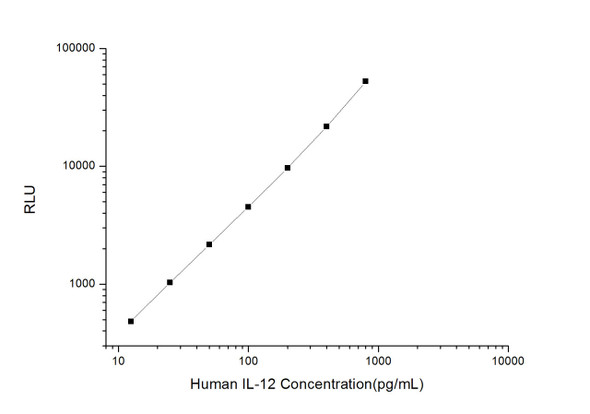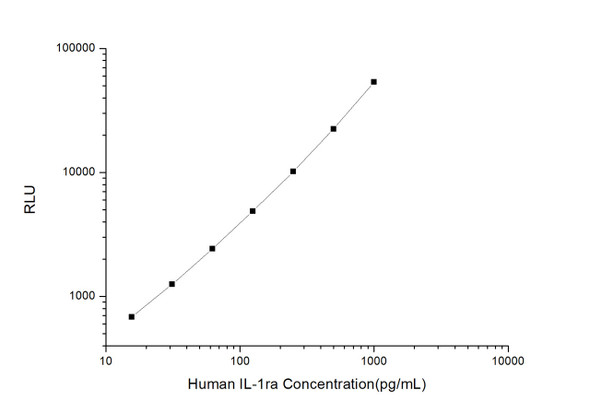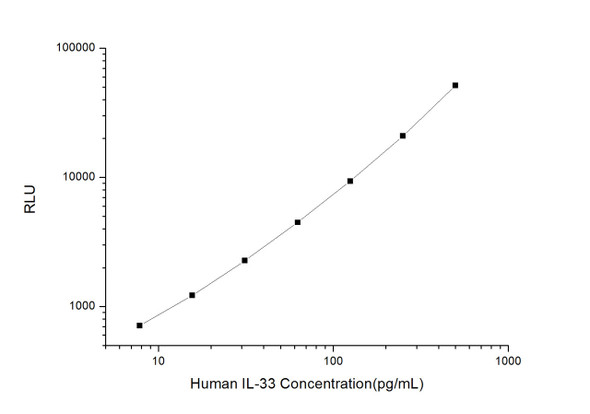Human Cell Biology ELISA Kits 3
Human IL-10 CLIA Kit (HUES00099)
- SKU:
- HUES00099
- Product Type:
- ELISA Kit
- ELISA Type:
- CLIA Kit
- Size:
- 96 Assays
- Sensitivity:
- 4.69pg/mL
- Range:
- 7.81-500pg/mL
- ELISA Type:
- Sandwich
- Synonyms:
- IL10, IL10A, CSIF, TGIF
- Reactivity:
- Human
- Sample Type:
- Serum, plasma and other biological fluids
- Research Area:
- Cell Biology
Description
| Assay type: | Sandwich |
| Format: | 96T |
| Assay time: | 4.5h |
| Reactivity: | Human |
| Detection method: | Chemiluminescence |
| Detection range: | 7.81-500 pg/mL |
| Sensitivity: | 4.69 pg/mL |
| Sample volume: | 100µL |
| Sample type: | Serum, plasma and other biological fluids |
| Repeatability: | CV < 15% |
| Specificity: | This kit recognizes Human IL10 CLIA Kit in samples. No significant cross-reactivity or interference between Human IL10 CLIA Kit and analogues was observed. |
This kit uses Sandwich-CLIA as the method. The micro CLIA plate provided in this kit has been pre-coated with an antibody specific to Human IL10. Standards or samples are added to the appropriate micro CLIA plate wells and combined with the specific antibody. Then a biotinylated detection antibody specific for Human IL10 and Avidin-Horseradish Peroxidase (HRP) conjugate are added to each micro plate well successively and incubated. Free components are washed away. The substrate solution is added to each well. Only those wells that contain Human IL10, biotinylated detection antibody and Avidin-HRP conjugate will appear fluorescence. The Relative light unit (RLU) value is measured spectrophotometrically by the Chemiluminescence immunoassay analyzer. The RLU value is positively associated with the concentration of Human IL10. The concentration of Human IL10 in the samples can be calculated by comparing the RLU of the samples to the standard curve.
| UniProt Protein Function: | IL10: Inhibits the synthesis of a number of cytokines, including IFN-gamma, IL-2, IL-3, TNF and GM-CSF produced by activated macrophages and by helper T-cells. Belongs to the IL-10 family. |
| UniProt Protein Details: | Protein type:Motility/polarity/chemotaxis; Cytokine; Secreted, signal peptide; Secreted Chromosomal Location of Human Ortholog: 1q31-q32 Cellular Component: extracellular space Molecular Function:growth factor activity; cytokine activity; interleukin-10 receptor binding Biological Process: B cell proliferation; negative regulation of chronic inflammatory response to antigenic stimulus; regulation of isotype switching; positive regulation of transcription, DNA-dependent; leukocyte chemotaxis; response to glucocorticoid stimulus; positive regulation of JAK-STAT cascade; negative regulation of B cell proliferation; negative regulation of membrane protein ectodomain proteolysis; response to insulin stimulus; negative regulation of interferon-alpha biosynthetic process; negative regulation of T cell proliferation; cytoplasmic sequestering of NF-kappaB; cell-cell signaling; positive regulation of MHC class II biosynthetic process; negative regulation of interferon-gamma production; response to molecule of bacterial origin; negative regulation of interleukin-6 production; hemopoiesis; negative regulation of tumor necrosis factor biosynthetic process; inflammatory response; aging; response to drug; response to inactivity; negative regulation of interleukin-12 production; positive regulation of B cell apoptosis; T-helper 2 type immune response; negative regulation of myeloid dendritic cell activation; negative regulation of nitric oxide biosynthetic process; negative regulation of cytokine secretion during immune response; regulation of gene expression; B cell differentiation; defense response to bacterium; negative regulation of MHC class II biosynthetic process; positive regulation of transcription from RNA polymerase II promoter; positive regulation of transcription factor activity; receptor biosynthetic process; response to activity; regulation of sensory perception of pain; negative regulation of apoptosis; positive regulation of cytokine secretion Disease: Graft-versus-host Disease, Susceptibility To; Rheumatoid Arthritis; Human Immunodeficiency Virus Type 1, Susceptibility To |
| NCBI Summary: | The protein encoded by this gene is a cytokine produced primarily by monocytes and to a lesser extent by lymphocytes. This cytokine has pleiotropic effects in immunoregulation and inflammation. It down-regulates the expression of Th1 cytokines, MHC class II Ags, and costimulatory molecules on macrophages. It also enhances B cell survival, proliferation, and antibody production. This cytokine can block NF-kappa B activity, and is involved in the regulation of the JAK-STAT signaling pathway. Knockout studies in mice suggested the function of this cytokine as an essential immunoregulator in the intestinal tract. Mutations in this gene are associated with an increased susceptibility to HIV-1 infection and rheumatoid arthritis. [provided by RefSeq, May 2011] |
| UniProt Code: | P22301 |
| NCBI GenInfo Identifier: | 124292 |
| NCBI Gene ID: | 3586 |
| NCBI Accession: | P22301. 1 |
| UniProt Related Accession: | P22301 |
| Molecular Weight: | 20,517 Da |
| NCBI Full Name: | Interleukin-10 |
| NCBI Synonym Full Names: | interleukin 10 |
| NCBI Official Symbol: | IL10 |
| NCBI Official Synonym Symbols: | CSIF; TGIF; GVHDS; IL-10; IL10A |
| NCBI Protein Information: | interleukin-10; T-cell growth inhibitory factor; cytokine synthesis inhibitory factor |
| UniProt Protein Name: | Interleukin-10 |
| UniProt Synonym Protein Names: | Cytokine synthesis inhibitory factor; CSIF |
| Protein Family: | Interleukin |
| UniProt Gene Name: | IL10 |
| UniProt Entry Name: | IL10_HUMAN |
As the RLU values of the standard curve may vary according to the conditions of the actual assay performance (e. g. operator, pipetting technique, washing technique or temperature effects), the operator should establish a standard curve for each test. Typical standard curve and data is provided below for reference only.
| Concentration (pg/mL) | RLU | Average | Corrected |
| 500 | 46630 56444 | 51537 | 51508 |
| 250 | 19398 22598 | 20998 | 20969 |
| 125 | 9865 8927 | 9396 | 9367 |
| 62.5 | 4190 4834 | 4512 | 4483 |
| 31.25 | 2415 2183 | 2299 | 2270 |
| 15.63 | 1348 1152 | 1250 | 1221 |
| 7.81 | 700 780 | 740 | 711 |
| 0 | 28 30 | 29 | -- |
Precision
Intra-assay Precision (Precision within an assay): 3 samples with low, mid range and high level Human IL10 CLIA Kit were tested 20 times on one plate, respectively.
Inter-assay Precision (Precision between assays): 3 samples with low, mid range and high level Human IL10 CLIA Kit were tested on 3 different plates, 20 replicates in each plate.
| Intra-assay Precision | Inter-assay Precision | |||||
| Sample | 1 | 2 | 3 | 1 | 2 | 3 |
| n | 20 | 20 | 20 | 20 | 20 | 20 |
| Mean (pg/mL) | 24.45 | 46.94 | 167.57 | 22.04 | 49.29 | 171.49 |
| Standard deviation | 3.13 | 5.51 | 16.12 | 2.52 | 5.52 | 13.31 |
| C V (%) | 12.80 | 11.74 | 9.62 | 11.43 | 11.20 | 7.76 |
Recovery
The recovery of Human IL10 CLIA Kit spiked at three different levels in samples throughout the range of the assay was evaluated in various matrices.
| Sample Type | Range (%) | Average Recovery (%) |
| Serum (n=5) | 92-106 | 98 |
| EDTA plasma (n=5) | 90-101 | 95 |
| Cell culture media (n=5) | 86-97 | 91 |
Linearity
Samples were spiked with high concentrations of Human IL10 CLIA Kit and diluted with Reference Standard & Sample Diluent to produce samples with values within the range of the assay.
| Serum (n=5) | EDTA plasma (n=5) | Cell culture media (n=5) | ||
| 1:2 | Range (%) | 91-105 | 99-114 | 83-96 |
| Average (%) | 96 | 105 | 90 | |
| 1:4 | Range (%) | 102-119 | 97-113 | 91-106 |
| Average (%) | 109 | 105 | 98 | |
| 1:8 | Range (%) | 87-99 | 99-116 | 94-106 |
| Average (%) | 93 | 106 | 100 | |
| 1:16 | Range (%) | 101-117 | 86-98 | 89-103 |
| Average (%) | 108 | 91 | 96 |
An unopened kit can be stored at 4°C for 1 month. If the kit is not used within 1 month, store the items separately according to the following conditions once the kit is received.
| Item | Specifications | Storage |
| Micro CLIA Plate(Dismountable) | 8 wells ×12 strips | -20°C, 6 months |
| Reference Standard | 2 vials | |
| Concentrated Biotinylated Detection Ab (100×) | 1 vial, 120 µL | |
| Concentrated HRP Conjugate (100×) | 1 vial, 120 µL | -20°C(shading light), 6 months |
| Reference Standard & Sample Diluent | 1 vial, 20 mL | 4°C, 6 months |
| Biotinylated Detection Ab Diluent | 1 vial, 14 mL | |
| HRP Conjugate Diluent | 1 vial, 14 mL | |
| Concentrated Wash Buffer (25×) | 1 vial, 30 mL | |
| Substrate Reagent A | 1 vial, 5 mL | 4°C (shading light) |
| Substrate Reagent B | 1 vial, 5 mL | 4°C (shading light) |
| Plate Sealer | 5 pieces | |
| Product Description | 1 copy | |
| Certificate of Analysis | 1 copy |
- Set standard, test sample and control (zero) wells on the pre-coated plate and record theirpositions. It is recommended to measure each standard and sample in duplicate. Note: addall solutions to the bottom of the plate wells while avoiding contact with the well walls. Ensuresolutions do not foam when adding to the wells.
- Aliquot 100µl of standard solutions into the standard wells.
- Add 100µl of Sample / Standard dilution buffer into the control (zero) well.
- Add 100µl of properly diluted sample (serum, plasma, tissue homogenates and otherbiological fluids. ) into test sample wells.
- Cover the plate with the sealer provided in the kit and incubate for 90 min at 37°C.
- Aspirate the liquid from each well, do not wash. Immediately add 100µL of BiotinylatedDetection Ab working solution to each well. Cover the plate with a plate seal and gently mix. Incubate for 1 hour at 37°C.
- Aspirate or decant the solution from the plate and add 350µL of wash buffer to each welland incubate for 1-2 minutes at room temperature. Aspirate the solution from each well andclap the plate on absorbent filter paper to dry. Repeat this process 3 times. Note: a microplatewasher can be used in this step and other wash steps.
- Add 100µL of HRP Conjugate working solution to each well. Cover with a plate seal andincubate for 30 min at 37°C.
- Aspirate or decant the solution from each well. Repeat the wash process for five times asconducted in step 7.
- Add 100µL of Substrate mixture solution to each well. Cover with a new plate seal andincubate for no more than 5 min at 37°C. Protect the plate from light.
- Determine the RLU value of each well immediately.






